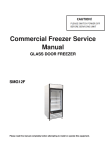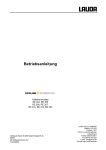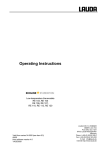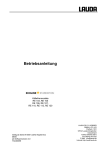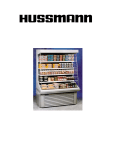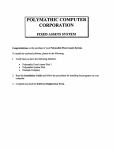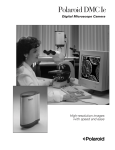Download Lightolier 1104F13ES Indoor Furnishings User Manual
Transcript
January 2006 INSTALLATION & SERVICE INSTRUCTIONS FOR DCCG and DCSG (-D) MODELS Dipping and Display Case First Call for help (US and Canada): 1-800-922-1919 Soporte Tècnico y Asistencia (Mèxico): 01-800-522-1900 For a Service Network Locator and other Information visit us at www.hussmann.com select Worldwide Locations P/N OII – DCCG - DCSG January 2006 HUSSMANN - GLOVERSVILLE TABLE OF CONTENTS Introduction Inspection 3 3 Specifications Construction Cabinet Dimensions Cabinet Capacities Electrical Data 3 4 4 4 Installation and Start Up 5 Location Power Requirements Start Up Procedures 5 5 5 Operation and Maintenance Temperature Control Display Lighting Anti-sweat Heaters Defrosting Condensing Unit Cleaning the Condenser Cleaning Exterior Cleaning Interior Serial Plate Location and Refrigerant Charges Temperature Control Replacement 6 6 6 6 7 7 7 7 7 7 Operational Data 8 Trouble Shooting Chart 8-9 1 TABLE OF CONTENTS CON’T Dipping Using Guide Loading Storage Lids Temperature Control Load Limits Dipping 10 10 10 10 - 11 11 11 Maintenance Warranty and Parts Information 11 12 - 13 2 INTRODUCTION, INSPECTION, SPECIFICATIONS INSTALLATION and START UP INTRODUCTION – durability. The entire assembly is then chemically treated and finished with baked-on powder paint. The liner is an all welded assembly of electro zinc steel. Copper evaporator tubing is fastened to the liner and applying a conductive material on both top and bottom of the tubing further enhances maximum heat transfer. The liner is also chemically treated and painted with baked-on powder paint. The DCSG/DCCG-4 8, 12, and 16 are specifically designed for dipping/display of bulk ice cream, sherbet, or frozen yogurt. Wide glass front and one-piece molded lids provide an unobstructed view of the product for impulse merchandising. Optional items include easy to use can holder trays and dipper wells. The –D models on -8, -12 and -16 include the labor saving storage doors feature. All models incorporate a slide-out condensing unit for easy access to all components. INSPECTION – Upon receipt of the cabinet, carefully examine the crating for damage. If damage is found, make a note on the delivery ticket before signing. Carefully remove shipping crate and examine the cabinet for “concealed” damage. If damage is found contact the delivering carrier immediately and have his agent prepare an inspection report for the purpose of filing a claim. This is your responsibility. SPECIFICATIONS CONSTRUCTION – The base is an all welded assembly of heavy dusty steel to provide a strong frame on which the rest of the cabinet is built. The shell is formed from heavy gauge steel, welded together as an assembly, and then welded to the base for strength and 3 CABINET DIMENSIONS – Cabinet Model DCSG/DCCG -4 -8 -12 -16 Dimensions (inches) Length Width Outside Inside Outside * Inside 25 3/8 21 47 7/16 43 1/8 67 5/16 63 87 7/16 83 1/8 * -D models Height Ship Outside Wt. 25 13/16 21 ½ 51 ¼ 25 13/16 21 1/2 51 1/4 25 13/16 21 1/2 51 1/4 25 13/16 21 1/2 51 1/4 (with doors) outside width = 27 9/16 260 405 515 625 CABINET CAPACITIES – Cabinet Model DCSG/DCCG -4 -8 -12 -16 Cu. Ft. Capacity (9 1/2 dia. 3 gal cans) Upper Display Lower Display 3.3 4 8.9 8 4 14.5 12 8 20.2 16 12 (Capacities of D models are the same as models without doors) # of lids 1 1 2 2 ELECTRICAL DATA Cabinet Model DCSG/DCCG -4 Volts HP 115 1/3 Compressor L.R. F.L. Amps Amps 33.0 6.4 Cabinet * Nominal Fuse Run Amps Amps 6.9 15 -8 115 1/2 58.0 8.6 9.5 15 -12 115 1/2 45.0 7.8 9.9 15 -16 115 3/4 59.8 10.2 10.5 15 (electrical data of D models are the same as standard models) * Includes main top heaters and condenser fan motors Due to compressor change from semi-hermetic to hermetic these are the value changes -8 (*hermetic) -12 (*hermetic) 115 115 ½ ½ 51.0 87.0 .9 7.9 8.4 12.0 15 15 * effective Aug. 2002 the DCCG/DCSG-8 compressor changed from a semi-hermetic HATB-005E-IAA to hermetic T2155GK. * effective Nov. 2003 the DCCG/DCSG-12 compressor changed from a semi-hermetic KAGB-0050-IAA to hermetic J2212GK Aspera 4 equipment on the same circuit. Use a time delay fuse or circuit breaker. The supply circuit must be properly grounded and conform to National and Local Electrical Codes. Voltage, as measured at the compressor terminals during operation, must not vary more than 5% from cabinet serial plate rating. If a low voltage condition exists, contact your electrician or power company. INSTALLATION and START UP LOCATION – The location of your cabinet is important. Make sure your selected location is NOT in any of the following areas as it could seriously affect the operation. • Not in direct sunlight. • Not in the air path of heat or air conditioning ducts. • Not at an exit or entrance affected by extreme temperature change. A wiring diagram is provided on the condenser shroud for each unit. A power (ON-OFF) switch is provided on each model. The switch is accessible through a hole provided in the rear (operator side) access panel START UP PROCEDURE - Allow 2 feet of clearance at the rear of the case to allow adequate air movement across the condenser for proper refrigeration system performance, do not obstruct the grille at the rear intake and discharge. If desired, the blank off panel behind the front (customer side) louvered panel – may be removed for rear air intake and front air discharge, but then insure 2 feet of unobstructed clearance is left at the case front. Level case front to back and end to end, shimming where necessary upon installation to assure proper operating drains, and refrigeration system. POWER REQUIREMENTS – The DC models are equipped with a three-wire grounded service core for your protection. The cabinets are designed to operate on 115V single-phase 60hz current. A separate circuit is recommended to prevent product loss due to overloading or malfunction of other 5 • Cut the band which holds the compressor in place during shipment. • Make sure fan turns freely. Check for any connections or parts that might have loosened during shipment. • Start cabinet, and allow temperature to pull down to normal level before loading product. OPERATION AND MAINTENANCE SERVICING DATA AND PROCEDURES OPERATION and MAINTENANCE • Raise top and canopy as an assembly and place wood spacers between top and cabinet. • Remove frame. • Disconnect spade terminal splices and remove. • Reassemble reverse order – resistance heater wire must be taped back into position TEMPERATURE CONTROL – The thermostat, which senses the cold wall temperature, is located at the lower rear right corner of the cabinet through the access panel. It has been pre-set at the factory to maintain product temperatures between +10° and +4°. The thermostat is adjustable. If other than normal temperatures are required, adjust the control by turning the knob clockwise for colder and counter-clockwise for warmer temperatures. under base DEFROSTING – It must be recognized that accumulation of frost on the cabinet walls does impair refrigeration. Daily scraping of the interior walls with a plastic scraper will extend the length of time between complete defrosting. DISPLAY LIGHTING – All models are equipped with fluorescent light fixtures installed in the canopy. An ON-OFF switch is located in the right service side of the canopy and is so labeled. Most installations will require a complete defrosting every seven to ten days. Usually the best time to defrost is at the close of business so the cabinet will be regulated for the start of the next business day. ANTI-SWEAT HEATERS – A resistance heater is installed in the perimeter of the base frame of the canopy to prevent condensation. Continuity of the heater circuit maybe checked at the splice located inside the ballast enclosure in the compressor compartment. The ice cream should be removed from the cabinet and placed in a walk-in or storage freezer during the defrosting operation. A power switch for turning the case off for defrosting is located through the access panel. Should the heater fail it may be replaced by: • heater from Defrosting may be accomplished with the aid of a hair dryer, plastic scraper or by merely letting the cabinet remain open until the walls are cleared. Care should Remove screws holding aluminum top to cabinet. 6 be taken not to puncture the interior walls or remove paint from the walls during this procedure. CLEANING EXTERIOR / INTERIOR – When cleaning the exterior of the cabinet use a soft cloth or sponge with water and mild detergent. Rinse and wipe dry. Be sure to disconnect power from the cabinet prior to starting defrost operation. After the cabinet is completely defrosted, wash thoroughly, remove defrost water (Hussmann dipping cases are provided with an outside drain located on the operator’s side of the case base to assist you in this operation), wipe the interior dry, and turn the power back on. Be sure to allow the cabinet to cool down to its operating temperature before reloading. For cleaning the interior of the product compartment, a built-in drain has been provided with a standard hose fitting located at the front of the cabinet in the base area. Disconnect the electrical power and allow cabinet to warm to above freezing temperature. Use a soft cloth or sponge with a mild detergent to wash the interior. Wipe dry before restarting the cabinet. Allow the cabinet to cool down to proper temperature before reloading product. CONDENSING UNIT – SERIAL PLATE LOCATION – The condensing unit is mounted on a slideout base, accessible by removing the rear serving side access panel. The condenser is of the baretube design. The condenser fan motor draws the air through the rear access panel, across the compressor and discharges back out the rear access panel unless the case has been Field converted to front air discharge as previously discussed in the Location section of this manual. For this reason, if the case is installed in a counter, provisions must be made for the release of the discharge air. One serial plate is located on the interior left wall of the cabinet, and a second one in the condensing unit compartment. Both contain all pertinent information such as model, serial number, amperage rating, refrigerant type and charge, etc. Specific charges are DCSG/DCCG-4 16 oz.,DCSG/DCCG-8 29 oz., DCSG/DCCG12 33 oz., and DCSG/DCCG-16 has 31 oz., all have R-404a. The “D” models have the same charge. CLEANING THE CONDENSER – The Ranco temperature control is located in the compressor compartment. To replace, first disconnect power supply and remove two screws holding control dial plate. Pull capillary tube from control well, noting length of tube removed. Push new cap tube into well, being careful not to kink it, and making certain it reaches full depth of well. TEMPERATURE CONTROL REPLACEMENT – To clean condenser, a soft, nylon brush should be used to loosen dirt and lint. Then vacuum up the dirt or blow condenser out with a high-pressure gas such as nitrogen. Never use a wire brush to clean condenser tubes. 7 Replace spade connectors and reinstall dial plate and two screws which hold control in place. Operational Data The following operational data is based on lab tests, and may vary under field conditions. The conditions shown at the non-recommended high 85°F ambient are shown for information only and a possible reason for jobsite problems. Note that during August, 2002, the DCC/SG-8 cases changed from semi-hermetic (SH) to hermetic (H) and similarly, during December, 2003, the DCC/SG-12 cases changed from the semi-hermetic (SH) to hermetic (H) style compressors which operate under different pressures. Model Compressor DCC/SG-4 NE2134GK HATB-005ECAA T2155GK KAGB-005EIAA 75°F Suction Head Pressure Pressure 9 230-240 Compressor Type H DCC/SG-8 &-D DCC/SG-8 &-D DCC/SG-12 &D DCC/SG-12 &D J2212GK KAAB-007EDCC/SG-16 &CAA D Load Line Temperature 85°F Suction Head Pressure Pressure 10 260-270 SH H 6 9 230-240 230-240 7 10 245-255 235-245 SH 6 235-245 7 250-260 H 10 230-240 11.5 260-270 SH 6 270-280 0 to +10°F 7 280-290 5 to +12°F TROUBLE SHOOTING CHART TROUBLE Compressor will not start, no noise PROBABLE CAUSE 1. Power disconnected 2. Blown fuse or breaker 3. Defective or broken wiring 4. Defective overload 5. Defective temperature Compressor will not start cuts out on overload 1. Low voltage 2. Defective compressor 3. Defective relay 8 SOLUTION 1. Check service cord for proper connection 2. Replace fuse or reset breaker 3. Repair or replace 4. Replace 5. Replace control 1. Check voltage at cabinet. Should be within 5% of rating 2. Replace 3. Replace 4. Restriction pinched cap tube 5. Restriction moisture 6. Inadequate air over condenser 7. Defective condenser fan motor TROUBLE High head pressure Warm storage temperatures PROBABLE CAUSE SOLUTION 1. Relocated cabinet 2. Clean condenser or remove air flow restriction 3. Replace motor 1. Temperature control not set properly 2. Short of refrigerant 1. Reset control 4. Leak check, change drier, evacuate and recharge 6. Heavy frost on side walls 2. Leak check, change drier, evacuate and recharge 3. Relocate cabinet 4. Purge system, change drier, evacuate and recharge 5. Check voltage at cabinet. Should be within 5% of rating 6. Defrost cabinet 1. Defective control 1. Replace 2. Control sensing element not completely installed in well 3. Short on refrigerant 2. Push control sensing element into well 5. Low voltage, compressor cycling on overload Compressor runs continuously, product too warm 5. Leak check, replace drier, evacuate and recharge 6. Allow at least 24” at front and back of unit compartment 7. Replace 1. Cabinet location too warm 2. Restricted condenser air flow 3. Defective condenser fan motor 4. Air or non-condensable gases in system 3. Cabinet location too warm 4. Too much refrigerant Compressor runs continuously, product too cold 4. Repair or replace tube 3. Leak check, change drier, evacuate and recharge 1. Short on refrigerant 1. Leak check, change drier, evacuate and recharge 2. Inefficient compressor 2. Replace 9 DIPPING USERS GUIDE The general success of any ice cream dipping department depends to a great extent on the people within that department. If at all possible, a single individual should be assigned the direct responsibility of assuring that proper operational procedures are being followed. LOADING – Careful thought should be given to the placement of flavors within the cabinet prior to the opening of the dipping department. Flavors with the highest sugar content (ripple, maple syrup, and candy) require a lower temperature for dipping than vanilla. Since temperatures will vary slightly within the cabinet, it is recommended that these flavors be placed in the corners where maximum cooling effect from two walls can be taken advantage of. STORAGE – In order to assure product quality and minimum energy usage, it is important that proper attention is given to the maintenance of product temperatures prior to placement in the display freezer. Storage temperatures are generally maintained at –12 degrees F to –18 degrees F. This allows for long-term storage of ice cream without deterioration. Dipping temperatures are generally maintained at +5 degrees F to +9 degrees F, which allows for rather limited display time before deterioration begins to occur. Ice cream removed from a delivery truck, walk-in freezer, or storage cabinet should be placed in the dipping cabinet immediately. The dipping cabinet is not designed as a hardening cabinet, and will generally only maintain ice cream at the preset dipping temperature. If ice cream is allowed to warm up prior to placement in the dipping cabinet, crystallization may occur resulting in some loss of product quality. LIDS – To conserve energy and minimize frost accumulation on the cabinet interior walls, the lids should remain closed until the customer has made his/her choice of flavors, and should be closed immediately once the customer has been served. Under no circumstances should the cabinet lids be left open for extended periods of time. 10 TEMPERATURE CONTROL – The temperature control is factory set for normal dipping temperatures. If, after a week or so of operation, it is decided that a higher or lower temperature is required, only a qualified refrigeration mechanic should adjust the control. Other than the initial adjustment and possibly a seasonal adjustment, no other setting should be required. If the cabinet temperature fluctuates to any great extent, a refrigeration mechanic should be notified. Employees should not be allowed to tamper within the control setting. LOAD LIMITS – • A fully loaded cabinet will use less energy and maintain generally more even temperatures than one that is only partially full. However, care should be taken not to exceed the load line limits as noted on the interior cabinet walls through the use of wire racks, stepshelving, or by stacking containers three high. DIPPING – Much of the success of hand dipping and appeal of the stored ice cream to the customer depends on the training of personnel in proper dipping methods. Periodic scraping of the container sidewalls and leveling off of the ice cream is essential to avoid discoloration and drying out of the ice cream. Scraping the container sidewalls and leveling off the ice cream should be done lightly with the use of a spade. Start with the back of the spade turned towards the side of the can, working from the top of the can down. Once the walls are cleared, the top portion of the remaining ice cream should be leveled off, filling in holes left by previous dipping. MAINTENANCE – • Proper maintenance of refrigeration equipment can have a dramatic effect on the equipment’s ability to perform, as well as power consumption and customer reaction to your dipping operation. Hussmann equipment is designed so that a minimum amount of maintenance is necessary. The relatively few items that do require attention should be scheduled for specific time periods based on prevailing store conditions and cabinet usage. 11 W ARRA NT Y – Please read carefully to assure prompt and accurate service Ordering Replacement Parts – • • • Contact your nearest Hussmann Distributor. Always specify model and serial number of cabinet. If correct part number is not known, give a clear description of part itself and its function in the cabinet. Warranty Parts Procedure – • Same as items above • Give original installation date of cabinet and, if possible, forward a copy of the original invoice or delivery receipt. • All shipments of in-warranty replacement parts will be invoiced from the factory until such time as the defective part is returned and proved to be defective by our Quality Control Department. Contact your Hussmann Distributor for instructions on returning in-warranty parts. Warranty parts must be returned to the factory within 30 days of date of failure to assure proper disposition. Lack of any of the above information may result in the shipment of the wrong part, or a delay in shipment. Compressor Replacement Procedure – Replacement compressors will not be shipped from the Hussmann factory. They may be obtained from your nearest Copeland Wholesaler. Your wholesaler will replace, free of charge, any compressor found to be defective within twelve months of installation, not to exceed twenty months from the date of manufacture, as determined by the compressor serial number on the compressor serial plate. For any defective compressor beyond the twelve or twenty month time period, a salvage value credit will be given too partially offset the invoice for the replacement. 12 BLUE LAMP BLUE LIGHT SWITCH WHT BLK RED BALLAST RED CANOPY HEATER WHT 26 28 6 23 25 31 27 29 5 BLK HIGH LIMIT SWITCH TEMPERATURE CONTROL BLK BLK 22 24 30 COMPRESSOR MOTOR OVERLOAD TERMINAL BLOCK C R S RELAY POWER CORD 115 VOLT 60 Hz 1 Ph BLK POWER SWITCH BLK WHT GRN START CAP. CONDENSER FAN WHT 1 S 2 M COMPRESSOR REV EO # REV DATE REV BY - APPROVED BY - - - USAGE: DCCG-4 TOLERANCES UNLESS OTHERWISE SPECIFIED: FRACTIONAL 1/32" DECIMAL 0.031" ANGULAR 1° HOLE LOCATION & SPACING 1/64" EO NUMBER WIRING DIAGRAM DRAWN BY: DATE DRAWN : APPROVED BY: JJH 01/29/2004 - GLOVERSVILLE, NY 12078 SCALE INCHES SHEET # 1 OF 1 M100-2309


















